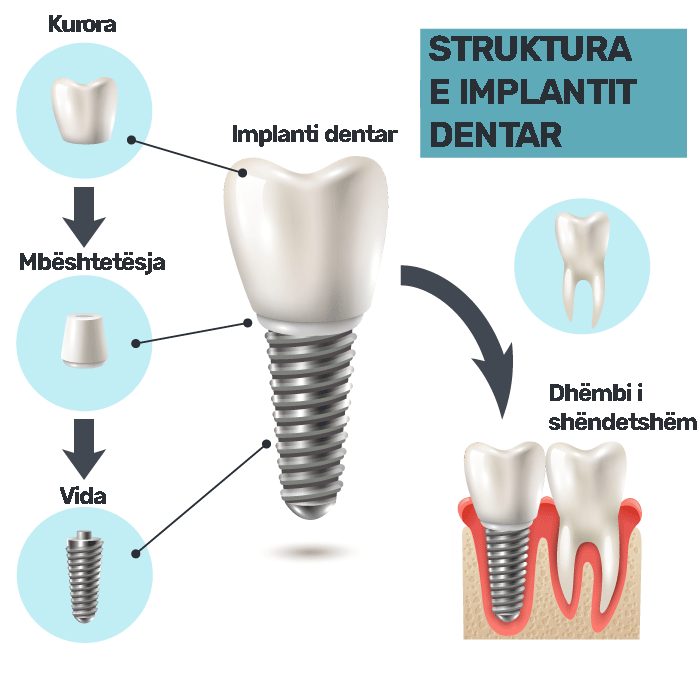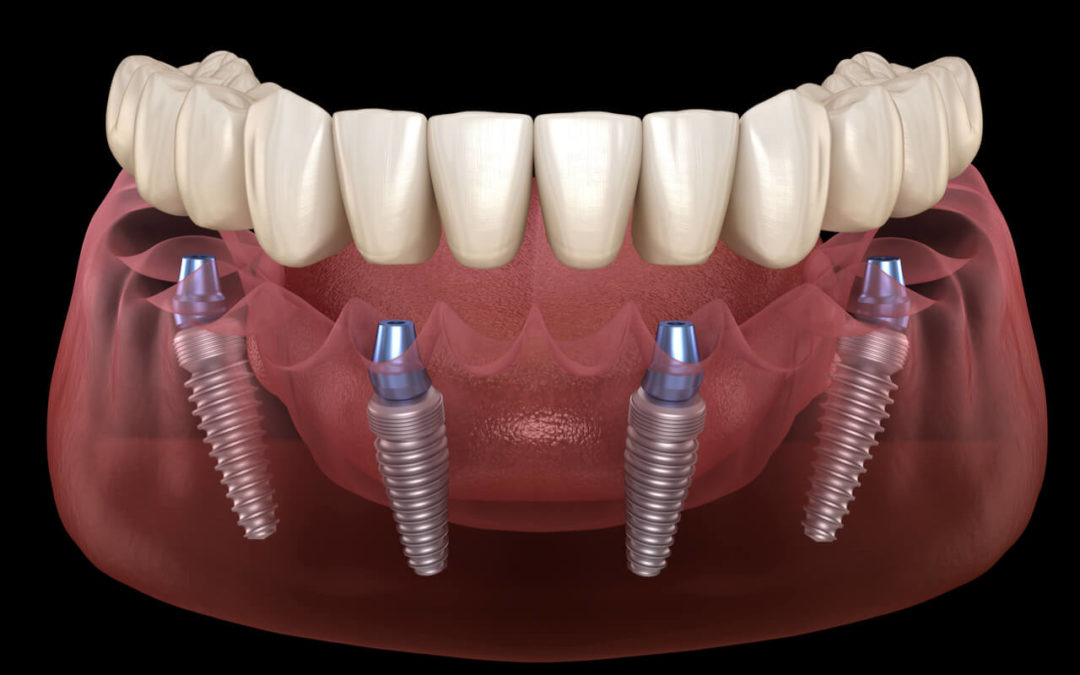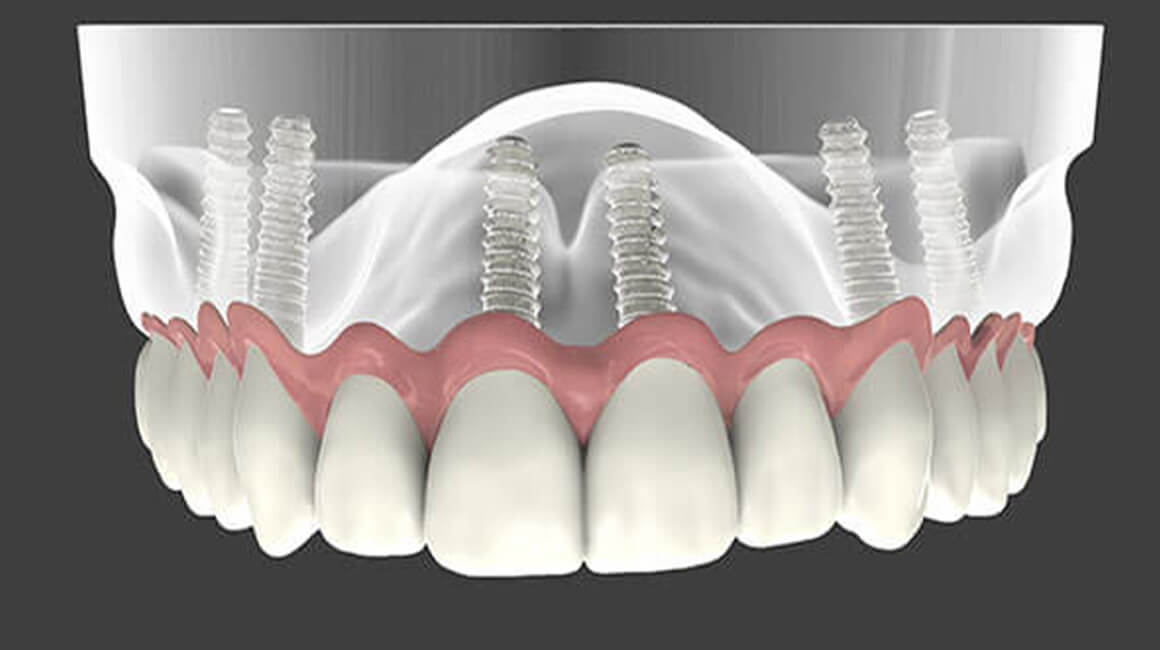What is a dental implant?
Dental implants are tooth replacement roots.
They are considered as the best way to replace missing teeth in the mouth.
Bridge over implants
Can you put a bridge over implants?
Placing the bridge over the implants is done with the same procedure as placing them over the real teeth. A fairly effective alternative that resolves situations when the patient has a significant lack of teeth; whether in the lower or upper jaw.
As with placing a tooth on the implant, the bridge over the implant can also be subject to failure. To avoid the risk of compromising the entire bridge structure, it is essential to follow a few rules:
- 1Take care of oral hygiene;
- 2Pay more attention to cleaning the parts that support the bridge;
- 3Periodic visits to the dentist
What kind of intervention is needed to place a bridge over implants?
The procedure for placing the bridge over the implants is the same as that of a normal implant surgery.
The intervention must be carefully planned. To do this, we start with the patient’s medical history and then proceed with all diagnostic tests.
Thanks to sophisticated technology the dentist will have digital and 3D images of the patient’s anatomy, and with the information gathered, he will be able to plan in detail the placement not only of the implant, but also of the bridge over the implants.


Dental Implants
All-on-4 Technique.
This technique is basically the same as placing a fixed prosthesis on six implants, but in this case 4 are placed, which serve to fix the prosthesis.
The choice between the techniques on six or four implants is influenced by the patient’s bone density, and other medical criteria he/she must meet.
“All-on-4” suitable in cases when:
– The patient has no teeth in one of the jaws
– The patient suffers from periodontitis
– The patient does not have sufficient jaw bone density
All on 6
All-On-6 Technique.
If you have lost all your teeth or have removable prostheses, a very effective way to restore the feeling of having your teeth once again is the “All-on-6” method. Thanks to this technique you can say goodbye to old prostheses with fixed prostheses placed on 6 implants.
Through this modern and innovative technique it is possible to place all teeth (12 or 14 teeth) in both the lower and upper jaw.If you have lost all your teeth or have removable prostheses, a very effective way to restore the feeling of having your teeth once again is the “All-on-6” method. Thanks to this technique you can say goodbye to old prostheses with fixed prostheses placed on 6 implants. Through this modern and innovative technique it is possible to place all teeth (12 or 14 teeth) in both the lower and upper jaw.
How is this technique applied?
The placement of the fixed prosthesis on 6 implants is done in two stages.
– The first stage consists of implant placement.
– The second stage, which comes after three or six months, consists of placing a fixed prosthesis.
Our clinic also offers the placement of temporary prostheses during the 3 or 6 month period of waiting for the process of implant integration with the bone. Making sure the patient doesn’t completely loose the functional side and of course the aesthetic side during this period.

The best quality products
The types of implants we use.
- Bio 3
- NOBLE BIOCARE
- NEO BIOTECH IS II
- NEO BIOTECH IS III
- ZYGOMATIC IMPLANTS
- SUBPERIOSTAL IMPLANTS
- PTERYGOID IMPLANTS
Bio3 implants are extremely successful products, thus ranking among the latest achievements of the German dental school and being parallel to the developments of global technology. This line of implants offers dentists the best solutions.
Reliability and Quality
Bio3 performs systematic checks on the quality of the products they produce, the latter confirmed by the international quality standards ISO 13485, ISO 9001, and CE0086.
Bio3 qualities
Precise conical connection that reduces the possibility of bacterial contamination. Hydrophilic surface that facilitates the work of the doctor and provides a stronger connection of the implant.
Dental implants are considered to be the best way to replace missing teeth. In cases where the patient has long ago lost the tooth, the surgeon must assess whether the remaining bone is large enough to hold the implant. When this is not enough, the primary treatment is to place an artificial bone to increase the stability of the implant. Also, in the areas of the molars, the surgeon assesses the proximity to the maxillary sinus membrane. When there is not enough space for the implant, the surgeon performs a procedure called “sinus lift” in which the bone and further the sinus membrane are exposed, and easily lifts the membrane with special instruments so that the implant has the right height to stand in line with the occlusion.
The Creos regenerative product line offers you a safe and reliable solution for bone regeneration (GBR) and tissue regeneration (GTR).
Implant system for all types
Whatever the type, we have the dental implant you need. Our aparatuses include bone and indoors implants for all bone types and all protocols.
Prefabricated and individual prostheses
We provide high security for restoring all problems. We receive the restored CAD / CAM prostheses from NobelProcera.
Concepts of innovative treatments
We treat the patient with our safe solution from a single tooth to the entire jaw.
The IS II implant passes through 5 stages of sterilization, enabling maximum implant pasteurization.
Solve the surface problem of S.L.A that is residual acid and impurities.
Fast connection to the bone
The RA value (approximate median) is almost the same as the “S” implant, which is known for surface implants.
And through clinical research, it has been proven that Neobiotech IS II has almost the same healing, bone health compatibility and implant S-stability.
Strong primary stability
IS II active body, head, apex and thread is a design that has strong primary stability even in cases of poor bone density.
Based on the studies of the last 10 years, IS II has been constantly improved to have an in-house design that allows stronger and faster bone links.
The IS III implant passes through 5 stages of sterilization, making possible the maximum implant pasteurization.
Solve the surface problem of S.L.A that is residual acid and impurities.
Fast connection to the bone.
The RA value (approximate median) is almost the same as the “S” implant, which is known for surface implants.
And through clinical research, it has been proven that Neobiotech IS III has almost the same healing and bone health time, implant S-stability.
Strong primary stability
IS III is the structure that creates primary stability even in cases where the patient has bone problems. Based on the studies of the last 10 years, IS III has been constantly improved to have an in-house design that allows for stronger and faster bone links.
Zygomatic implants are an evidence-based surgical and prosthetic solution for both two-phase and immediate loading protocols.
Nowadays, zygomatic implants are normally placed using an immediate loading protocol.
The primary indication for zygomatic implants is severely resorbed maxilla, but they can also be used in situations of partially edentulism.
Indications for zygomatic implant placement are: alternative to sinus augmentation, failure of sinus augmentation, rehabilitation after trauma or tumor removal, failure of conventional implants, failure of previous bone grafts.
The placement of zygomatic implants requires qualified training and surgical experience.
If you need a dental implant but you suffer from bone loss in your jaw, you are a candidate for a subperiosteal implant.
Unlike most implants that are placed into the bone, this type of implant lies on top of the jawbone underneath the thin layer of tissue between bone and gingiva (periosteum).
Pterygoid implants are the best solution for situations of severe bone resorption in the upper jaw.
They are placed in the back of the upper jaw, skipping regeneration of the bone and shortening the time of placing the teeth on the implant.
